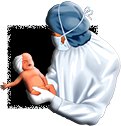|
Many couples experiencing difficulty having a child turn to
assisted reproductive technology to combat infertility. Methods
of assisted reproduction include in vitro fertilization, or
assisted fertilization outside of the body, and individual
sperm injections into the mother's egg. These are reported
as safe, if not completely natural, ways to have a child,
but research has not evaluated their risks. Are infants conceived
using assisted reproduction more likely to suffer from birth
defects than naturally conceived infants?
The prevalence of major birth defects in infants conceived
with assisted reproduction was determined in this Western
Australian study, published recently in The New England
Journal of Medicine. Between 1993 and 1997, the prevalence
of major birth defects was calculated for three groups: approximately
300 infants conceived with sperm injection, over 800 conceived
with in vitro fertilization, and 4,000 natural births.
 Compared
to natural births, the odds for a major birth defect were
doubled for both groups of assisted-reproductive-technology
infants. Also, infants conceived using reproductive technology
were at a higher risk for multiple major birth defects, and
defects in muscles, bones, and chromosomes. Assisted reproductive
births were more likely to involve Cesarean section, pre-term
birth, and low birth weight. Compared
to natural births, the odds for a major birth defect were
doubled for both groups of assisted-reproductive-technology
infants. Also, infants conceived using reproductive technology
were at a higher risk for multiple major birth defects, and
defects in muscles, bones, and chromosomes. Assisted reproductive
births were more likely to involve Cesarean section, pre-term
birth, and low birth weight.
If you are contemplating assisted reproduction, consider
all of the risks involved to yourself and the child before
you elect to use the procedure. Weigh all the alternative
options available, including adoption, and ask yourself: Is
it worth the risks?
Reference:
Hansen M, Kurinczuk JJ, Bower C, et al. The risk of major
birth defects after intracytoplasmic sperm injection and in
vitro fertilization. The New England Journal of Medicine
2002:346(10), pp. 725-730.
To read more articles on consumer safety, go to https://www.chiroweb.com/find/archives/general/consumer/index.html.
|



